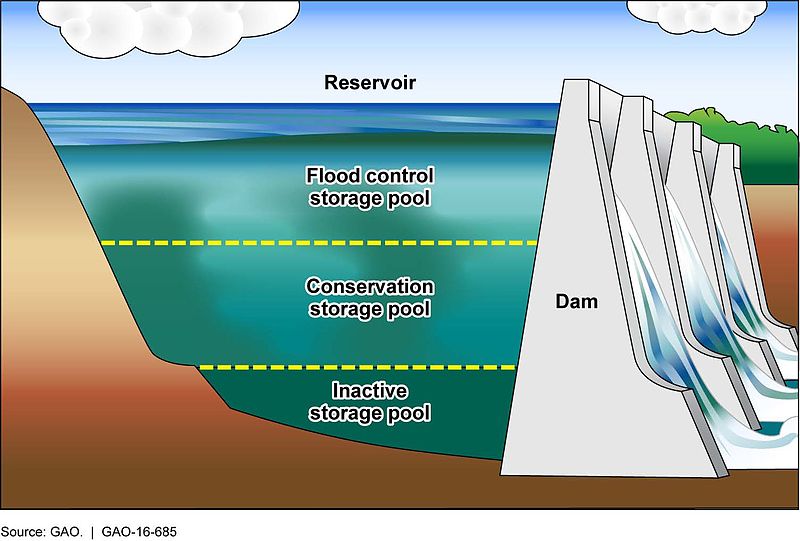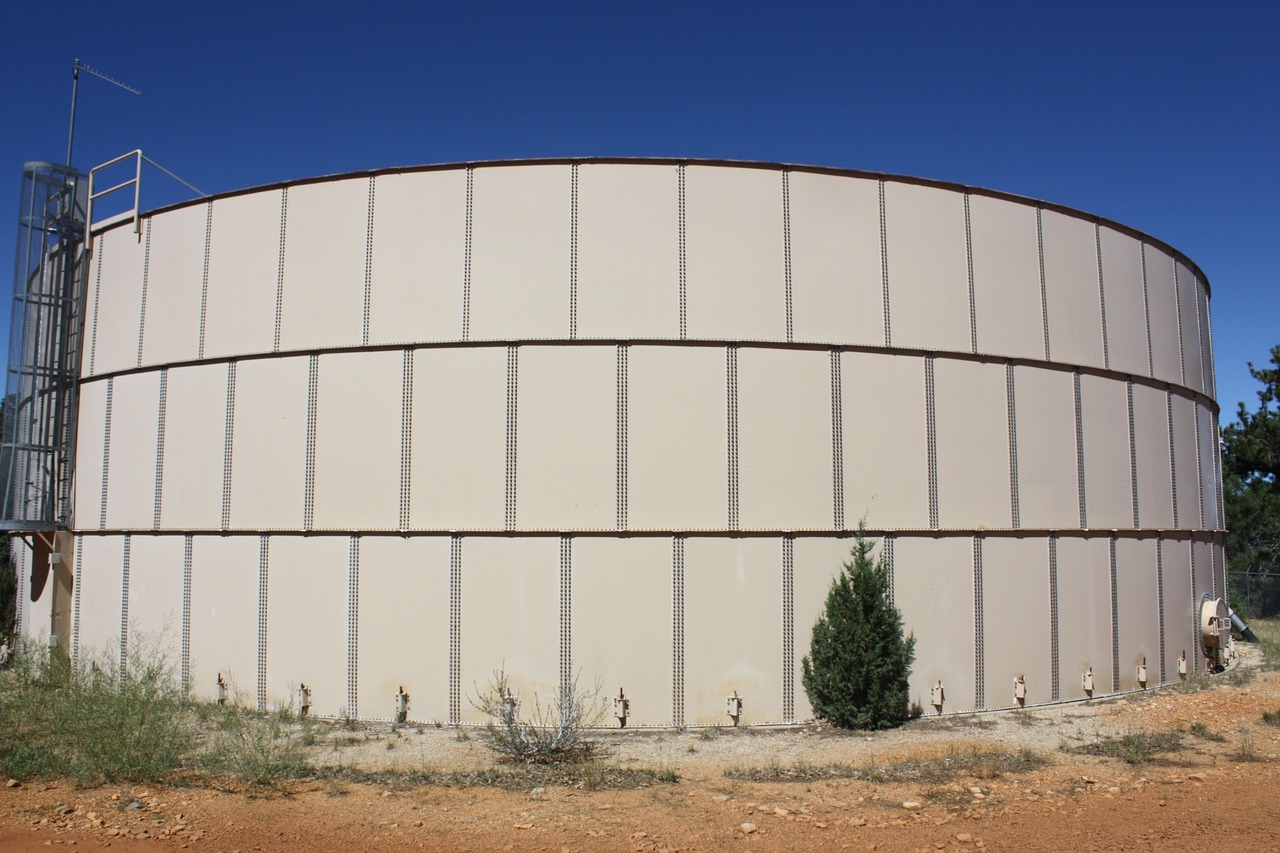Storage Reservoirs
.jpg)
Illustration of a U.S. Army Corps of Engineers' Reservoir, with Pools Allocated for Different Uses ,source : wikimedia commons
Reservoirs are structures that store water.
generally, it has been reported that there is high flow in winter and low flow in summer, and very high values in spring months or snowmelt seasons in Northern Hemisphere.
On the other hand, the water demand is high in summer and low in winter.
Therefore, the regulation of the streamflow is required to meet the demands.
This regulation is possible by constructing reservoirs in the stream.
Water supply, irrigation or hydroelectric project drawing water from a stream may be unable to satisfy the demands of its consumers during extremely low flows. This stream, which may carry little or no water during portions of the year, often becomes a raging torrent after heavy rains and hazard to all activities along its bank. A storage, or conservation, reservoir can retain such excess water from periods of rainy season for use during periods of drought. In addition to conserving water for later use, the storage of flood waters may also reduce flood damage below the reservoir. Because of fluctuations in both supply and demand of water, most cities find it necessary to have reservoirs to help equilibrate the flows.
Design Characteristics of Reservoirs
Since water storage is the main function of a reservoir, determination of the storage capacity either graphically or analytically is very important. For this purpose, a flower hydrograph (that is, graph of discharge versus time) for the river or stream at the site where the reservoir is to be built must be obtained for a large number of years (20-30 years). From this flow hydrograph, the mass curve of inflow which is the commulative inflow versus time can be drawn below
The mass curve of demand is computed from the hydrograph of demand in the same way as mass curve of inflow is computed from the hydrograph. The demand rate is seldom uniform and usually varies from season to season.
If you take a proper examination of the mass curve above, cd appears to be the driest period on record and ab is the volume of storage required to provide water for this period. If there are more than one dry periods, the maximum departure is the storage capacity required (to meet the uniform line demand).
The capacity of a reservoir designed primary for flood control does not depend on the pattern of demand to be met during a cycle of dry years but on the maximum flood hydrograph of the river at the reservoir site and the safe channel capacity downstream. The following points must be noted in the hydrograph.
Firstly, the reservoir is assumed to be full at the start of drought period, i.e at c. It is full again at e.
L is the spilling reservoir and to find the maximum uniform flow possible for a given storage, locate the line with the smallest slope which will be tangent to the mass curve and have a maximum departure from it equal to the assumed storage volume.
The analysis is performed after adjusting for evaporation and seepage losses. This will enable the determination of the storage in the worst case which will be used in design.
Capacity Area Curve
The surface areas and capacity at given elevations are obtained from the topographical map of the reservoir site. The areas could be obtained from the trapezoidal or Simpson's Rule. The trapezoidal rule is given by
Where h= constant contour interval and y¡= elevations at cross -section i.
The cross sections of the reservoir site are sometimes surveyed and the capacities computed from the vertical cross sections. Generally, the surface areas and capacities are plotted against the elevations. These curves are very useful for estimation of the reservoir elevation and area at different volume.
Reservoir Losses
Losses in reservoirs can occur through evaporation (water lost to the atmosphere); seepage (water is lost when the reservoir is underlain by porous strata) and silting (through soil erosion of the watershed). Silting destroys useful storage and reduces the useful life of a reservoir. To minimize these losses, it is usual to adopt measures like Evaporation and silting control.Evaporation and Silting Control
Evaporation control is usually done by spreading oil on the reservoir surface. However, its effectiveness may be reduced by bacterial decomposition of the film, destruction by wind and wave and absorption onto shore and vegetation.
Silting control cannot be prevented but it can be retarded by adopting some measures like, avoid reservoir sites which have many sources sediments, since silt originates in the watershed, adopt soil conservation measures, practice cover cropping, strip cropping, terracing and benching on steep hill slopes and other practices that reduce erosion, provide sluice gates at various levels of the dam to permit the discharge of fine sediments and finally, sediment deposits in tanks and small reservoirs may be removed by excavation, dredging, draining and flushing either by mechanical or hydraulic methods.Probable Life of a Reservoir
The rate at which the capacity of a reservoir is reduced by the deposition of sediment depends on sediment load, i.e the rate of sediment inflow, percentage of sediment inflow retained in the reservoir, i.e trap efficiency and the density of the deposited sediment.
These factors are necessary before the probable life of a reservoir can be predicted. The useful capacity of reservoir lost each year by sediment deposition is
Vs=.Qs nt
Where
Vs= volume of usual capacity of reservoir lost each year;
Qs = Sediment load of the reservoir, and
nt= Trap efficiency of the reservoir become covered by vegetation resulting in heavy evapotranspiration loss of the available water.
Conclusion
In conclusion, a reservoir can be an artificial lake or large freshwater body of water that provide a supply of water when naturally occurring bodies of water, such as lakes or rivers, run dry. There are three main types of reservoirs; valley-dammed reservoirs, bank-side reservoirs, and service reservoirs
Reservoir provide the raw water feed to a water treatment plant which delivers drinking water through water mains. The reservoir does not merely hold water until it is needed: it can also be the first part of the water treatment process.
Reference
[1] Reservoir
[2] estimate of water Storage
[3] Flow duration analysis and reservoir storage
[4] Environmental impact of reservoirs
[5] What is a reservoir? -study


Also, reservoirs can be used as man made lakes.
Sediment deposition inside water body should be completely ban. If such is accomplished, the nature will thank us for that.
Nice review
Well, I can only say in the changing world where we would be facing the water scarcity very soon these reservoirs are going to be very helpful in those days. We must made more such structures and also save the water whatever we can.
Cheers
Being A SteemStem Member
I had issues understanding reservoirs when i was little.. Reservoirs can be wonderful especially when it is a large one. They can be used as relaxation too. And just like @addempsea said man made lakes.
Yeah, washed said so.